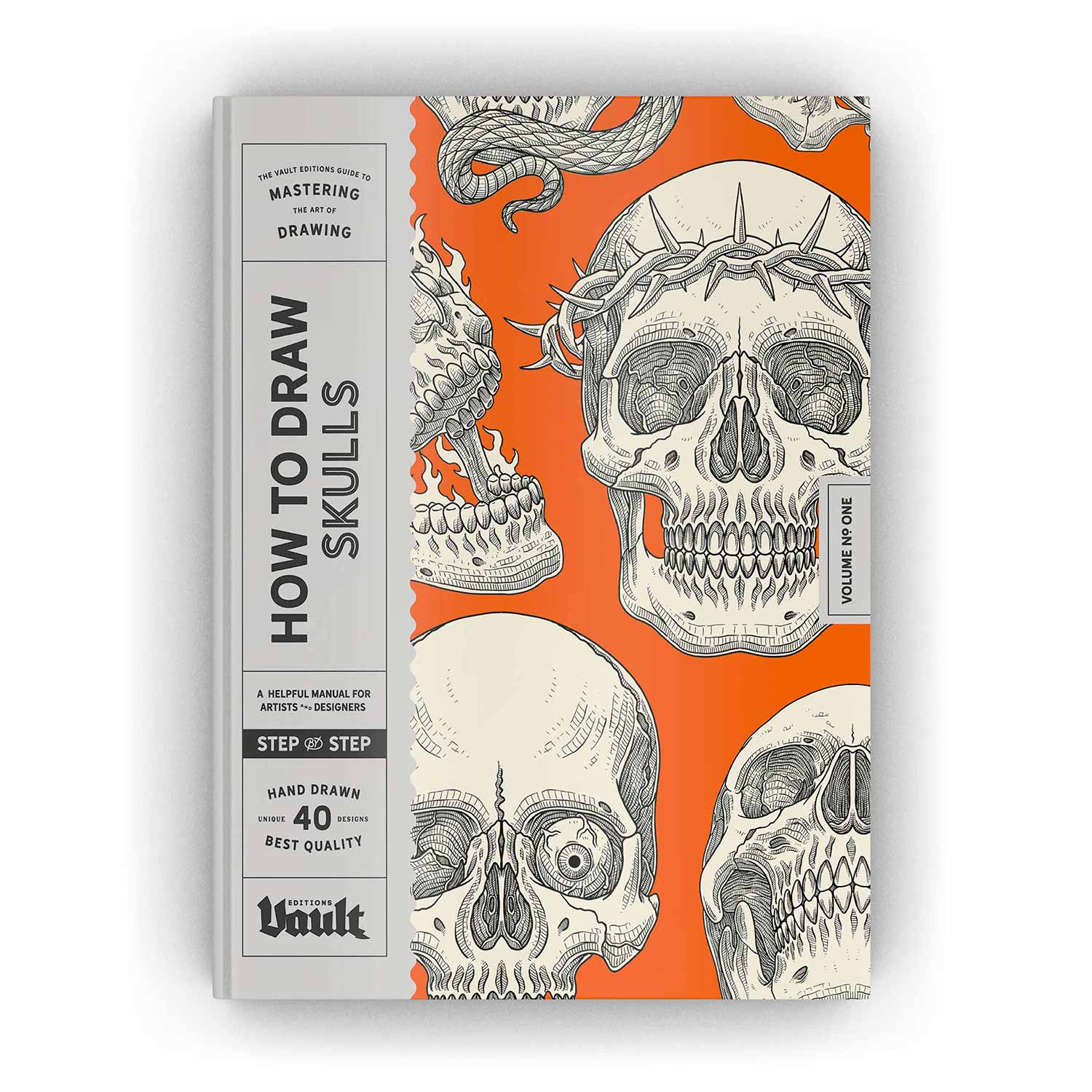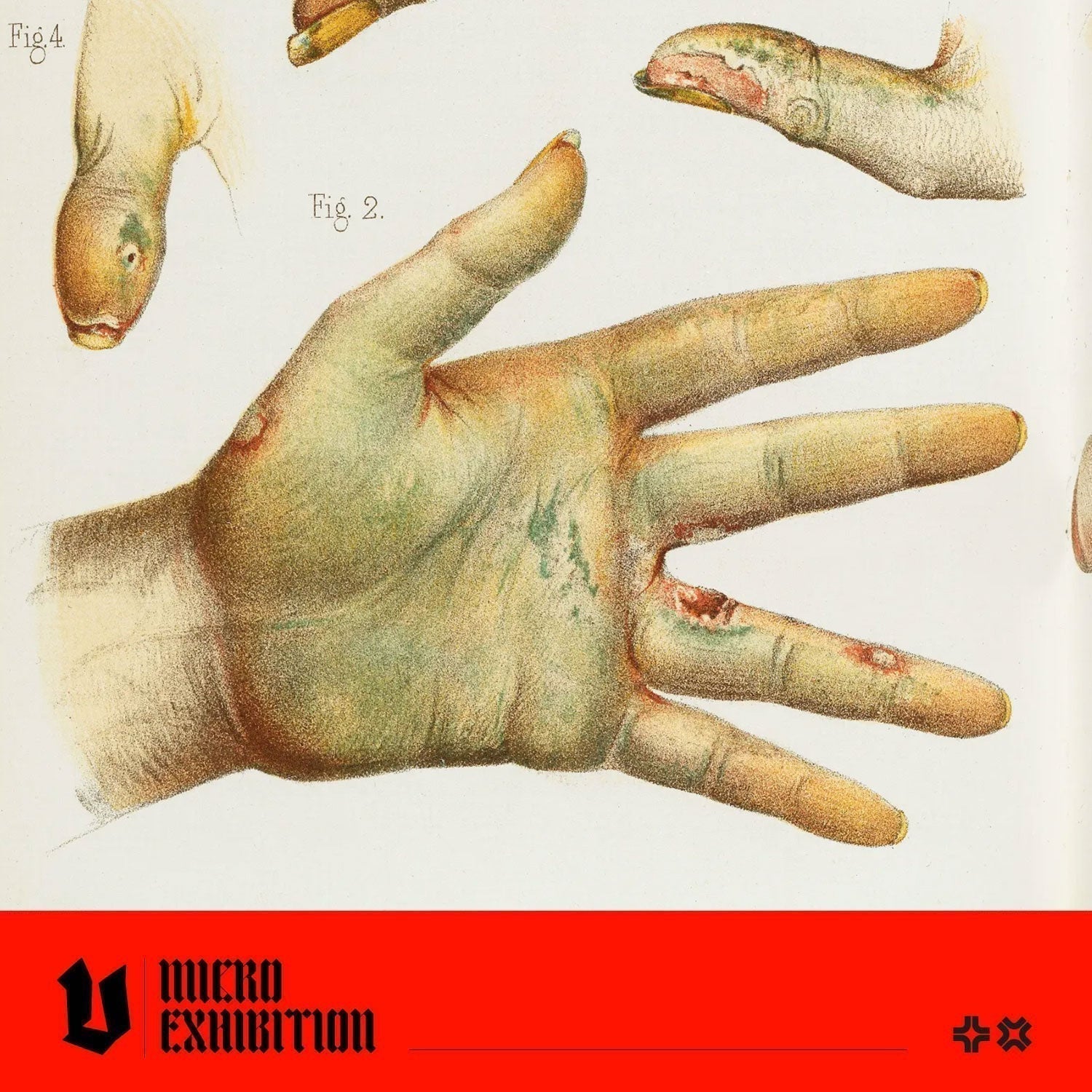How to Draw a Skull:
Step-by-Step Guide for Beginners
Want to learn how to draw a skull step by step? Whether you're a complete beginner or just looking for an easy skull drawing tutorial, this guide will walk you through the process of sketching a human skull from the front view. You'll learn how to build the basic structure using simple shapes and draw accurate features, such as the eye sockets, nasal cavity, and teeth.
This tutorial is ideal for beginners, hobbyists, and anyone seeking a straightforward approach to drawing skulls. It's just one of 40 beginner-friendly designs featured in Vault Editions' How to Draw Skulls: A Step-By-Step Guide to Drawing Skulls, Skull Anatomy, and Creative Skull Designs for Beginner and Experienced Artists, a book packed with easy, 12-step skull drawing tutorials, from classic anatomical skulls to spooky and stylised versions. Grab a pencil and let's get into it.
Step 1: Draw the Skull's Basic Guide Shape
Start by drawing a large oval to represent the upper part of the skull, which will form the cranium. Then, draw a vertical centre line down the middle of the oval. This line helps you maintain the symmetry of the skull's features. Next, extend the vertical line slightly downward below the oval. This will help guide the placement of the jaw later on.
Step 2: Add Eye and Cheek Guidelines
Using the oval as your base, draw two horizontal curved lines across it. These lines should follow the round shape of the skull; they will help you place the eyes and brow area correctly.
Next, add two vertical lines dropping down from the edges of the oval. These mark the sides of the skull and where the cheekbones will later extend down into the jaw.
These construction lines don't need to be perfect; they're just there to help guide the structure.
Step 3: Sketch the Eyes, Nose, and Jawline
Now it's time to block in the key features of the skull.
- Eye sockets: Use the upper curved guideline to draw two rounded rectangles or soft squares, one on each side of the vertical centre line. These should sit evenly between the side guidelines and slightly below the top curve. Don't worry about symmetry being perfect; skulls often aren't.
- Nasal cavity: In the centre, draw a shape like an upside-down heart or an abstract triangle with rounded sides. This sits just below the lower curved guideline.
- Jawline: Use the bottom of the vertical oval and the vertical side lines to sketch a wide U-shape for the lower half of the skull. Let the ends flare out slightly to hint at the jawbones. This gives the skull its distinctive shape and structure.
You're now starting to see the skull take form!
Step 4: Block in the Teeth Area
In this step, we'll sketch the shape that will guide the placement of the teeth.
- Just below the nasal cavity and above the bottom of the jawline, draw two slightly rounded rectangles stacked on top of each other. These represent the upper and lower rows of teeth.
- Use the vertical centre line to keep them aligned, and let the corners curve gently to match the contours of the jaw.
- Don't draw individual teeth just yet; think of this as a placeholder, a simple shape to help position everything.
At this stage, the face of the skull is beginning to take shape. You've got the sockets, the nose, the jaw, and now the area for the teeth.
Step 5: Draw the Cheekbones
Now it's time to give your skull some structure by adding the cheekbones.
- Starting near the top outer corners of each eye socket, draw a curving line that extends outwards and then dips inward toward the edge of the teeth area.
- These lines form the upper ridge of the zygomatic bone, the part that gives the skull its distinct cheek structure.
- Ensure that both sides mirror each other, but don't worry about achieving perfect symmetry. Human skulls have natural variation, and a bit of wonkiness adds character.
These curves are essential in giving your skull a more lifelike and dimensional look. You're moving from a flat face into something that starts to feel solid.
Step 6: Add the Jawline
Now it's time to complete the lower part of the skull by adding the jaw.
- From the bottom ends of your cheekbone lines, extend a smooth curved line down and around to connect just below the teeth area.
- These lines form the jawbone (mandible), giving the skull its signature rounded base and strong silhouette.
- Keep the curve slightly wider at the bottom to suggest the strength and weight of the bone.
With this step, your skull now has its complete outer structure in place. From here, you'll refine and add details - the basic shape is ready!
Step 7: Refine the Eye Sockets and Nose
Now that you've blocked in the structure of the skull, it's time to sharpen some key facial features.
- Add slight curves beneath the nose cavity; these represent the inner contours of the nasal bones.
- Then draw angled lines at the top inner edges of the eye sockets to define the brow ridge. These small details add depth and structure to the face.
- Finally, sketch a subtle line where the jaw connects beneath the cheekbone, to suggest the jaw hinge.
These adjustments give your skull more character and anatomical accuracy, and it's starting to look recognisably skeletal now!
Step 8: Add the Teeth
Time to bring the mouth area to life, or rather, death.
- Begin by drawing vertical lines to divide the top and bottom rows into individual teeth. Use the centre guide as a reference for symmetry.
- The front teeth (incisors) are wide and rectangular, then gradually taper into smaller shapes as you move toward the molars at the back.
- Don't worry about perfect accuracy, focus on making the teeth evenly spaced and gently curved to follow the shape of the mouth.
This step instantly makes your skull feel more recognisable and expressive. It's a great moment to pause and admire your progress; the structure is now taking shape.
Step 9: Refine the Skull with Facial Bone Details
Now we'll add some of the smaller anatomical features that bring your skull to life.
- Start by outlining the separation between the eye sockets and the nasal bone. Use curved, organic lines that follow the contours of the face.
- Add small notches and subtle shapes around the cheekbones, jaw, and temple areas to show where different bones meet.
- Draw the small oval shapes on either side of the nose; these represent the infraorbital foramina (tiny holes in the skull through which nerves pass).
- Below the mouth, sketch in two slight curves for the mental foramina on either side of the chin.
These features might seem minor, but they make a big difference in giving your drawing anatomical structure and realism.
Step 10: Add the Teeth
Time to bring the mouth to life by adding the individual teeth.
- Start by sketching out the top row of teeth (the maxillary teeth). Use vertical oval or teardrop shapes, slightly pointed at the bottom and wider at the top.
- Draw the front four teeth first; these are the central and lateral incisors. They should sit evenly on either side of the centre line.
- Next, draw the canines, which are slightly more pointed and sit beside the incisors.
- Fill in the rest with premolars and molars, which are broader and more rectangular.
- Repeat the same process for the lower row (mandibular teeth), lining them up with the top row but with a slightly smaller scale.
Don't worry about making each tooth identical; variation adds realism. Just aim for symmetry across the centre line.
Step 11: Add Cracks and Final Details
To complete your skull drawing, it's time to add the finishing touches that give it character and realism.
- Lightly sketch in natural bone texture and fracture lines across the skull; these usually follow the sutures where the bones fuse.
- Emphasise the eye sockets and nasal cavity with deeper curves and shading lines.
- Add hairline cracks, small pits, and subtle asymmetries to create a more aged, realistic look.
- Use a fine line to trace over the final outline of the skull, then gently erase your construction lines if needed.
This step is all about texture and detail; take your time. The cracks and subtle marks are what bring the skull to life.
Optional: Add Shading and Detail
Once you've completed the line work, you can bring your skull to life with shading. Use hatching, stippling, or crosshatching techniques to define form, create depth, and highlight the hollow contours of the eye sockets, cheekbones, and jaw.
This step adds character and dimension to your drawing, giving it a polished, professional finish. Don't worry about perfection; the goal is to experiment and build confidence in your style.
 That's it! You've just completed an easy skull drawing from scratch! If you enjoyed this step-by-step skull drawing tutorial, there's plenty more in How to Draw Skulls: A Step-By-Step Guide to Drawing Skulls, Skull Anatomy, and Creative Skull Designs for Beginner and Experienced Artists. This book features 40 original skull drawing tutorials designed for beginners and hobbyists. Each one is broken down into 12 simple steps, helping you build confidence and improve your drawing skills while creating cool, tattoo-inspired skull art. Whether you're into anatomy, gothic design, or want to draw something fun, this book has you covered.
That's it! You've just completed an easy skull drawing from scratch! If you enjoyed this step-by-step skull drawing tutorial, there's plenty more in How to Draw Skulls: A Step-By-Step Guide to Drawing Skulls, Skull Anatomy, and Creative Skull Designs for Beginner and Experienced Artists. This book features 40 original skull drawing tutorials designed for beginners and hobbyists. Each one is broken down into 12 simple steps, helping you build confidence and improve your drawing skills while creating cool, tattoo-inspired skull art. Whether you're into anatomy, gothic design, or want to draw something fun, this book has you covered.
Ready to keep going? Pick up your copy of How to Draw Skulls and start sketching your next design today.
















